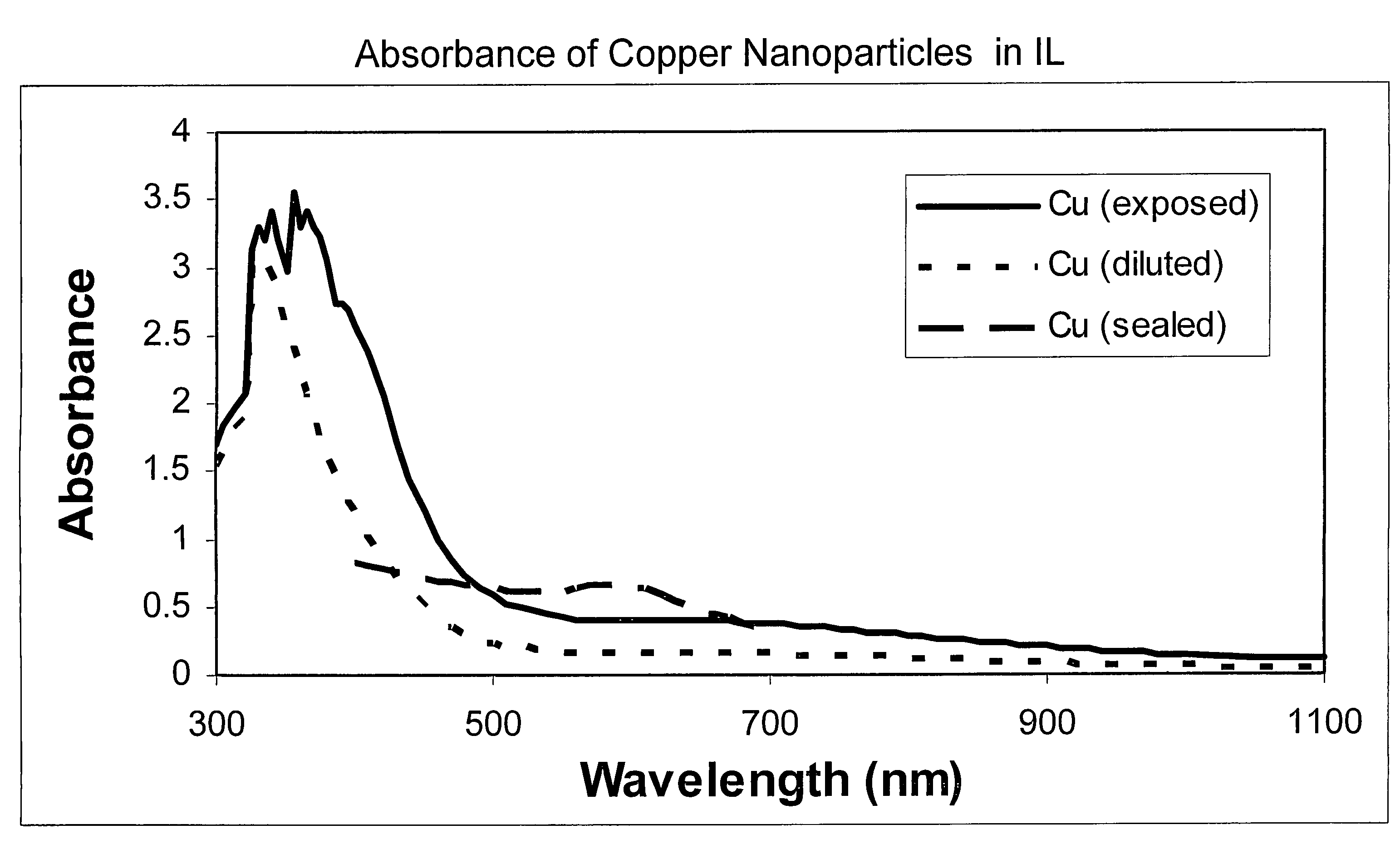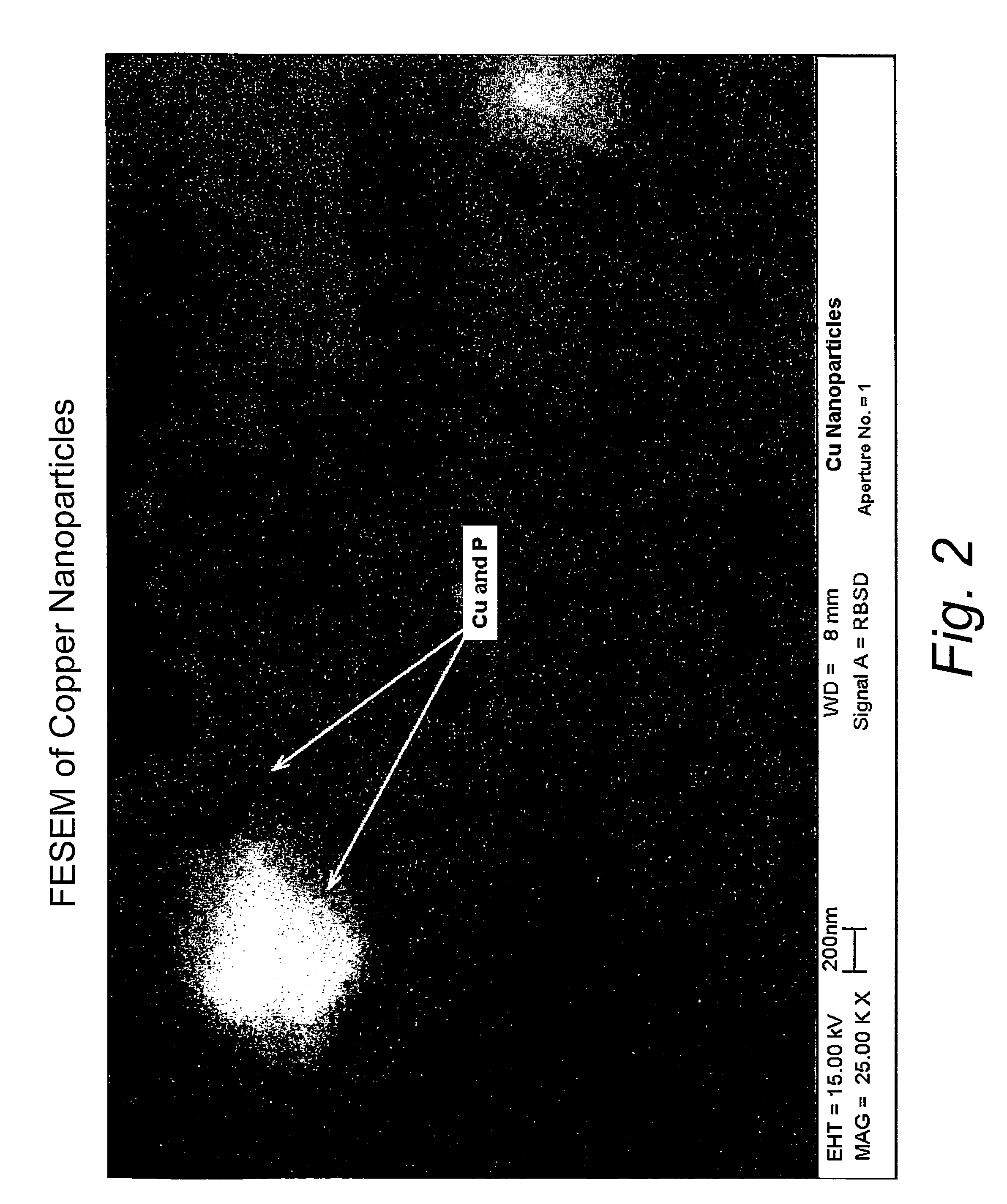Method of producing particles by physical vapor deposition in an ionic liquid
a technology of ionic liquid and physical vapor deposition, applied in the direction of metal/metal-oxide/metal-hydroxide catalyst, chemical/physical process, conductive materials, etc., can solve the problems of difficult or hazardous work, and not being able to meet the requirements of the work environmen
- Summary
- Abstract
- Description
- Claims
- Application Information
AI Technical Summary
Benefits of technology
Problems solved by technology
Method used
Image
Examples
example 1
[0032]This example illustrates the formation of copper nanoparticles. Copper was deposited from a copper target at a constant power of 1.5 kW, a voltage of 508 volts, and a current of 2.95 amps in an argon gas atmosphere at a pressure of 4 microns of Hg. The substrate passed under the target 20 times. After deposition, the sample was removed from the chamber. The area of the glass surface surrounding the ionic liquid ([BMIM]PF6 described above) was covered with a copper film, as expected. The IL, however, appeared unchanged, except for a transmitted color that appeared reddish-brown in color, and which developed a greenish component after about 4 minutes. If the copper containing IL were left in the coater under vacuum for at least 4 minutes, and then removed, the IL was the reddish-brown color without the greenish hue. However, the hue developed after about 4 minutes, as previously described. If the sample was covered with glass plate upon removal from the coater, the solution rema...
example 2
[0040]This example illustrates the formation of silver nanoparticles. Silver was deposited in a manner similar to the method described in Example 1 for copper. The silver was deposited at a constant power of 3.0 kW, a voltage of 599 volts, and 5.0 amps in an argon gas atmosphere at a pressure of 4 microns of Hg. The substrate passed under a silver target 10 times. The silver containing IL was removed from glass substrate by rinsing in acetone into a collection dish. The silver film thickness was 463 nm as measured at the boundary between the film and the uncoated area that contained the IL. This is equivalent to about 470 μg per square cm of silver as calculated from the density derived from XRF measurements for sputtered silver films. The particle removal was performed by diluting the silver containing IL in the dish several additional times with acetone, removing acetone and IL after each dilution with filter paper. The acetone was then allowed to evaporate until a film of agglome...
example 3
[0044]This example illustrates the formation of tungsten oxide nanoparticles. Tungsten oxide was deposited in a method described above. A tungsten target was deposited in a reactive gas atmosphere of 50% O2 and 50% Ar by flow at a pressure of 4 microns of Hg. The target was run at a constant power of 3.0 kW, a voltage of 486 volts, and a current of 6.24 amps. The substrate passed under a target 10 times. The tungsten oxide containing IL was removed from glass substrate by rinsing in acetone into a collection dish. The tungsten oxide was 117 nm thick (as determined in the manner discussed above). The tungsten oxide containing IL had a yellow appearance when viewed in transmittance. It is believed that this coloration is due to either the presence of tungsten oxide in the IL or a reaction of the plasma with the IL. The particle removal was performed by initially diluting the tungsten oxide containing IL in the dish with acetone and removing acetone and IL with filter paper. However, i...
PUM
| Property | Measurement | Unit |
|---|---|---|
| diameter | aaaaa | aaaaa |
| diameter | aaaaa | aaaaa |
| diameter | aaaaa | aaaaa |
Abstract
Description
Claims
Application Information
 Login to View More
Login to View More - R&D
- Intellectual Property
- Life Sciences
- Materials
- Tech Scout
- Unparalleled Data Quality
- Higher Quality Content
- 60% Fewer Hallucinations
Browse by: Latest US Patents, China's latest patents, Technical Efficacy Thesaurus, Application Domain, Technology Topic, Popular Technical Reports.
© 2025 PatSnap. All rights reserved.Legal|Privacy policy|Modern Slavery Act Transparency Statement|Sitemap|About US| Contact US: help@patsnap.com



